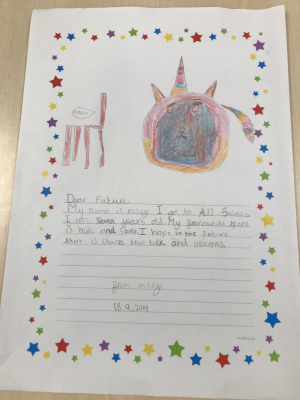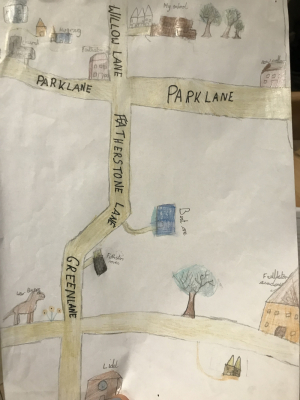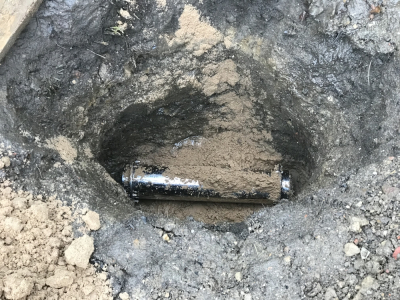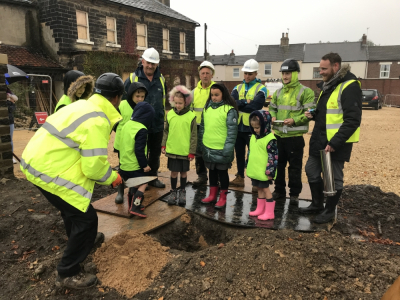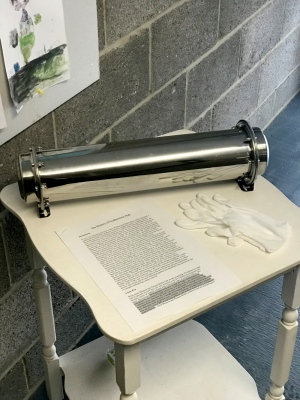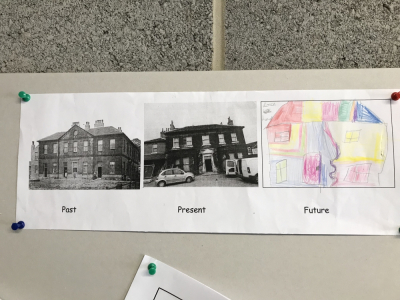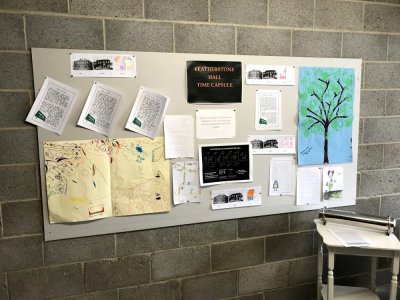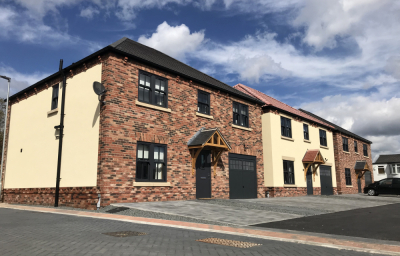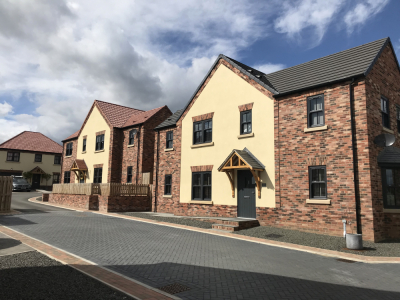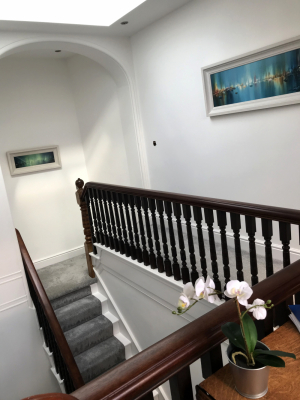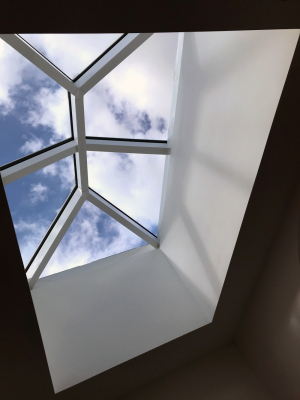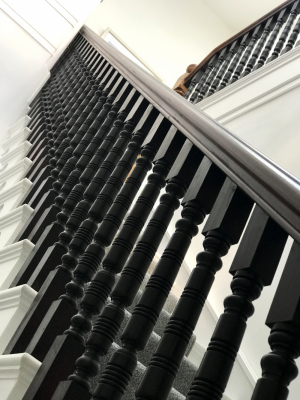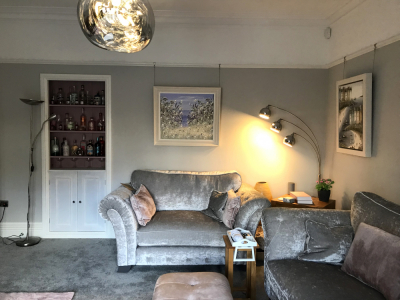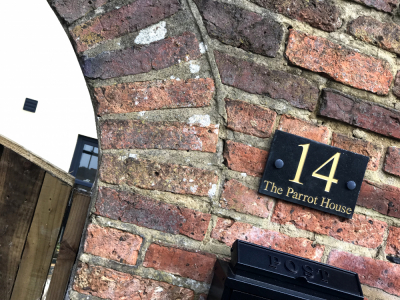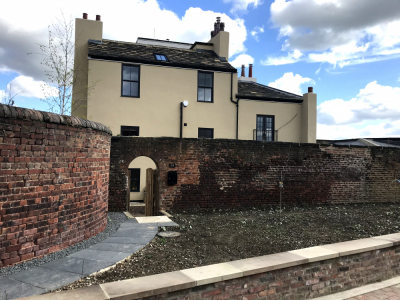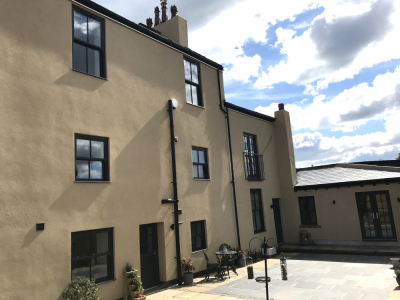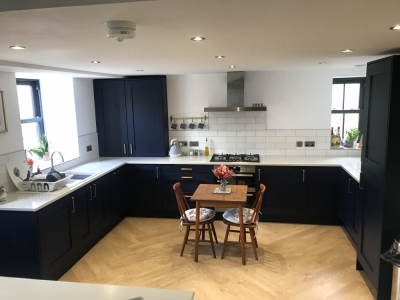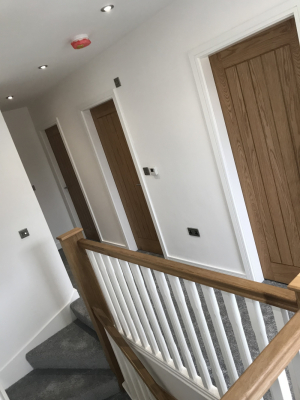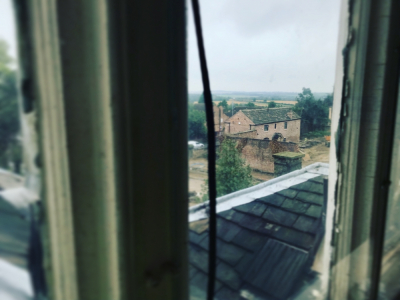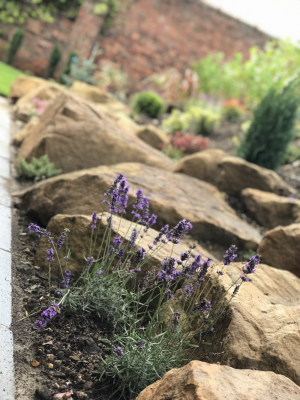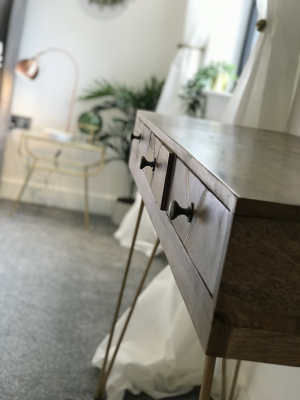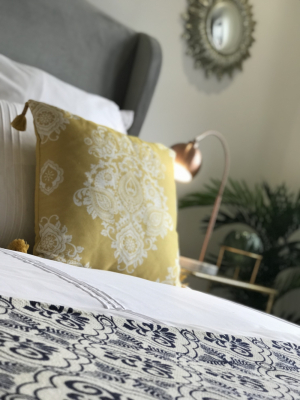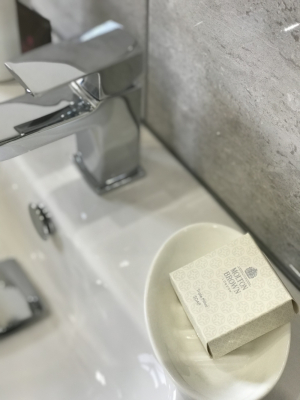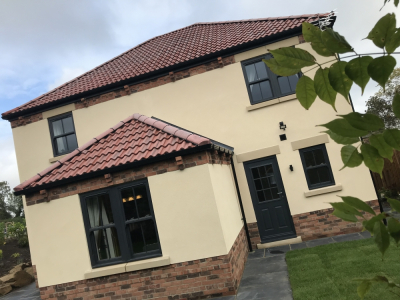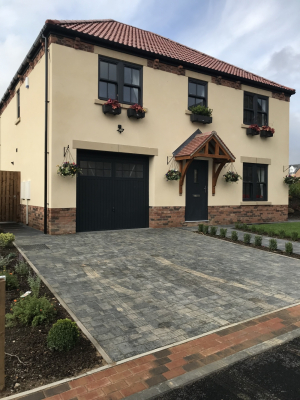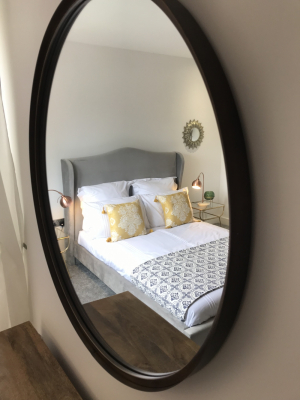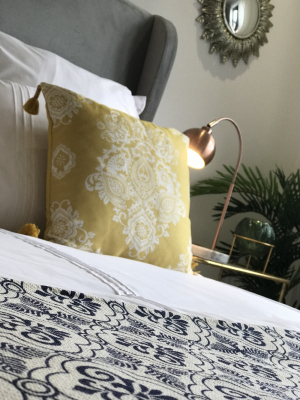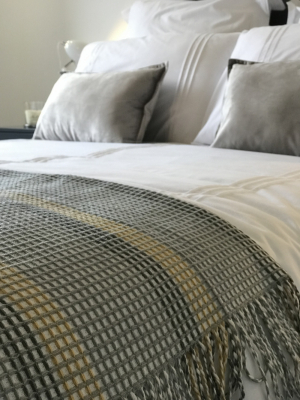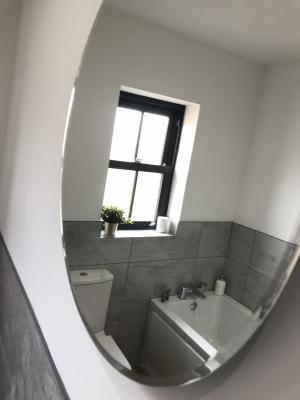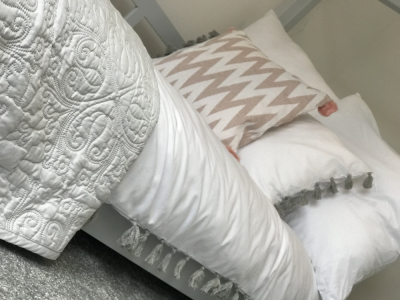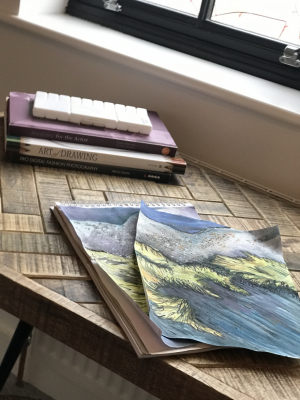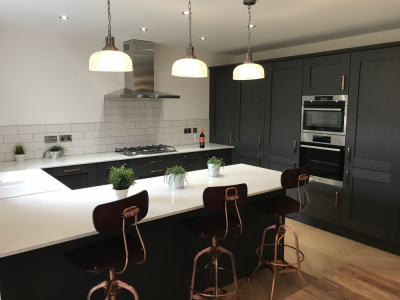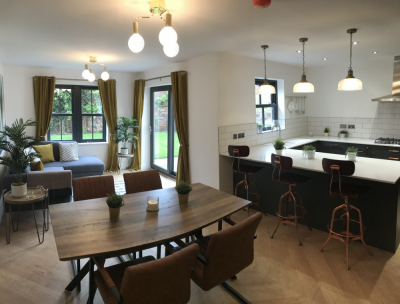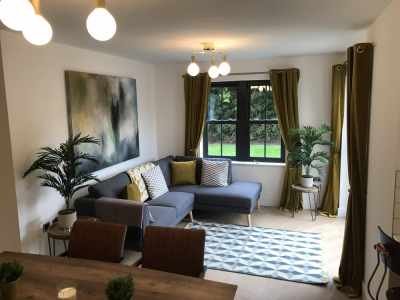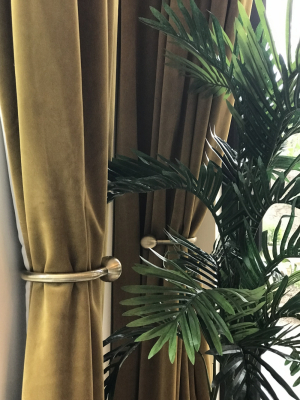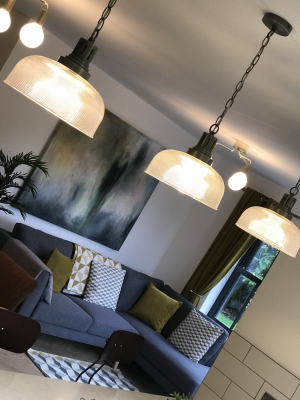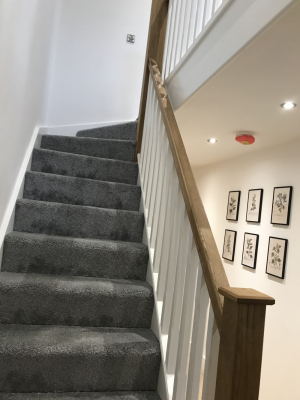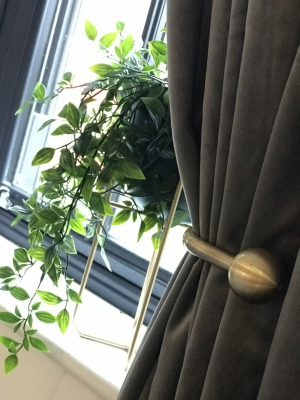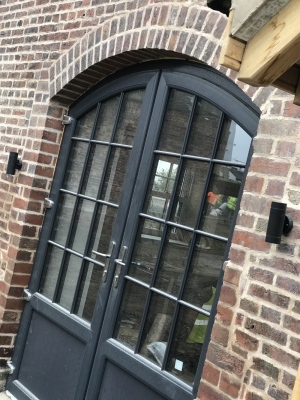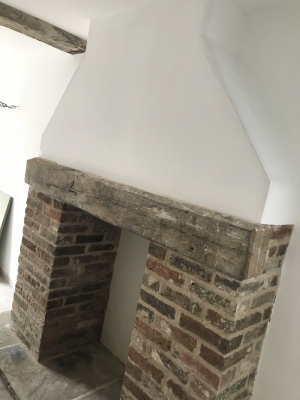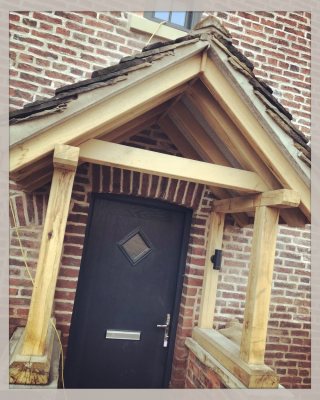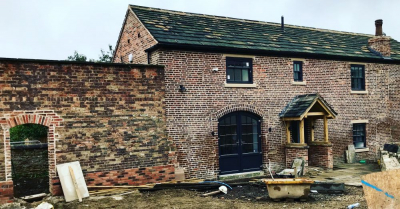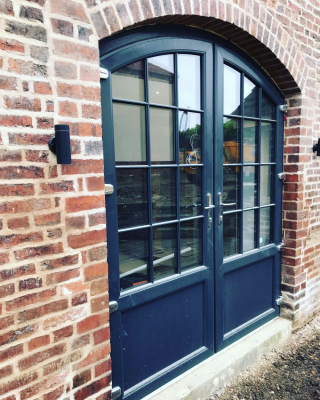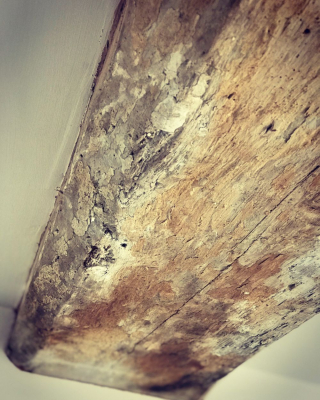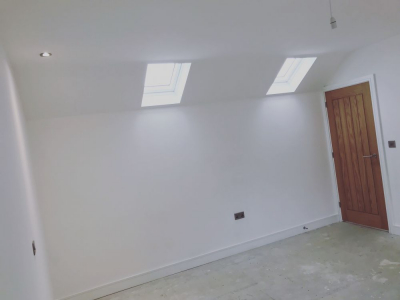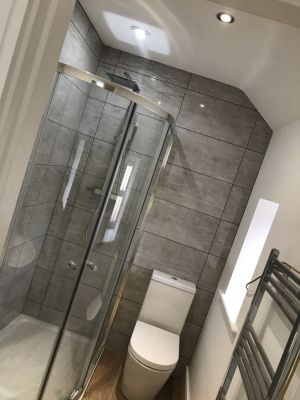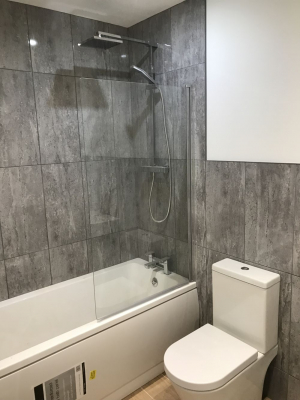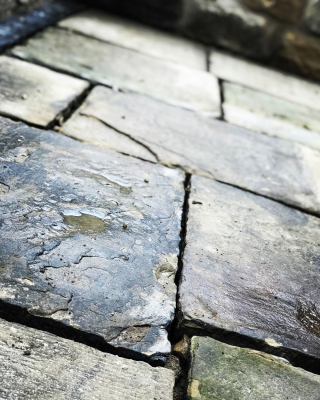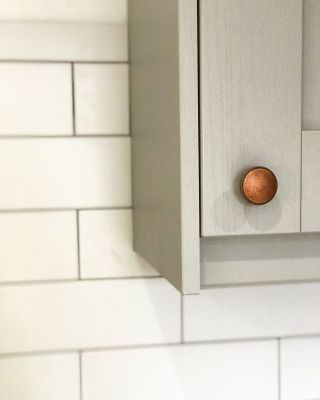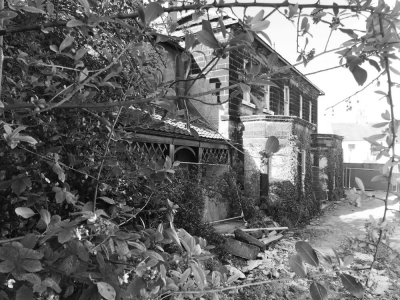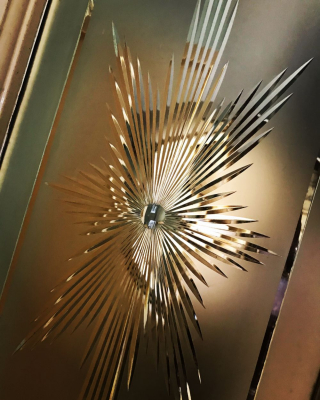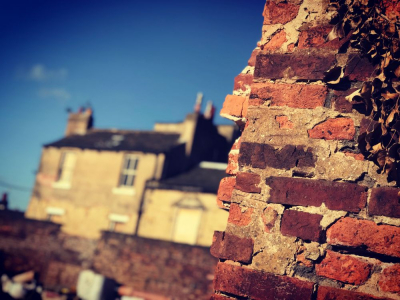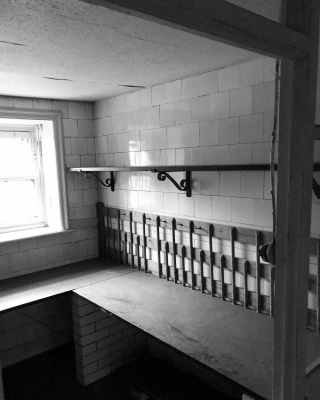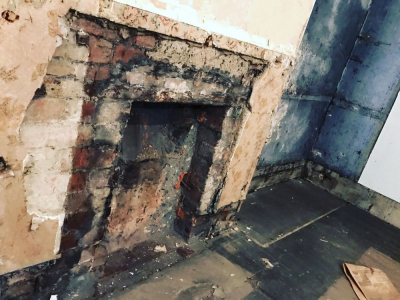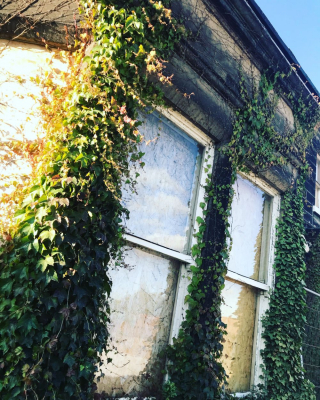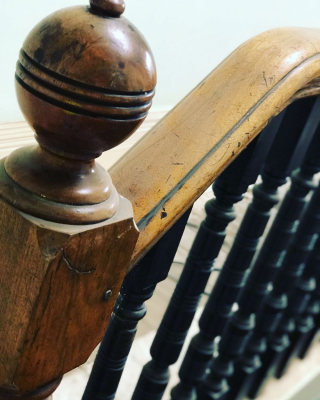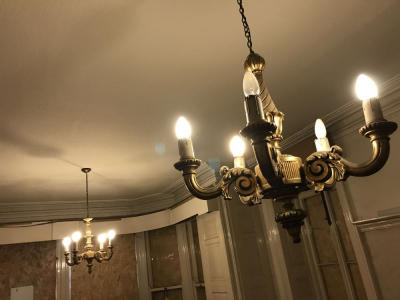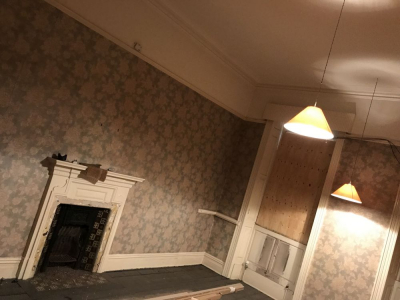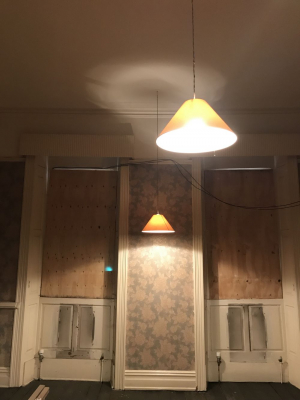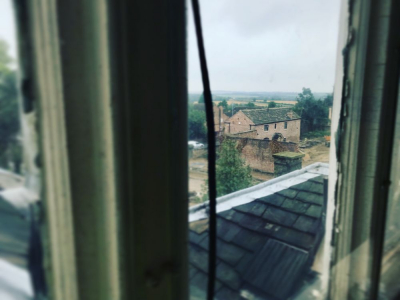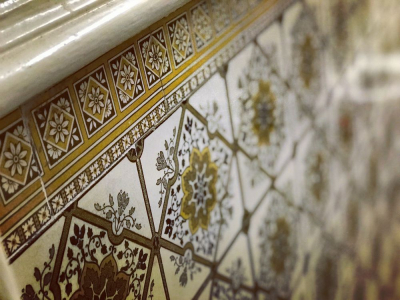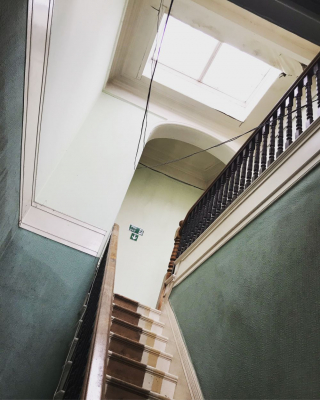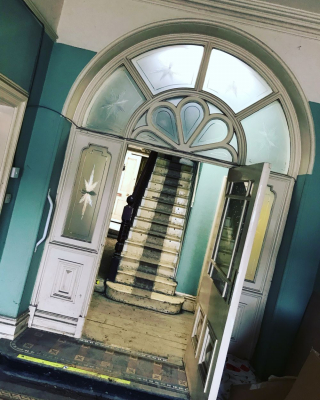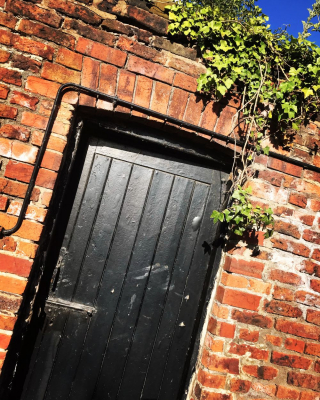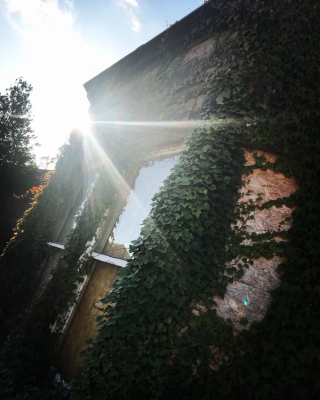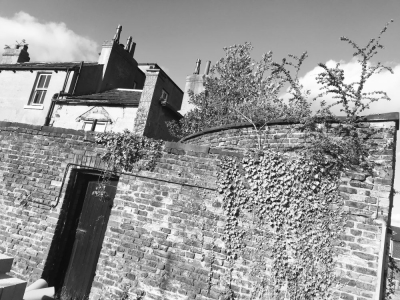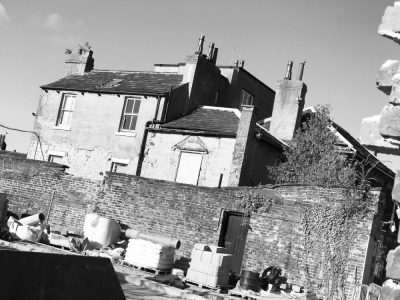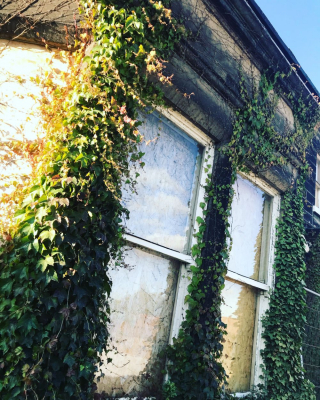Featherstone Hall remains the last standing of four great houses that once dominated this village, and stands on a parcel of land with a thousand years’ worth of recorded history.
Since being registered in the doomsday book, the land has been in the hands of Norman nobility, an important Plantagenet family, a Knight who backed the Royalist cause during the civil war, Baronets from an ancient seat, a builder of railways, a Quaker banker and poet who sat as a Liberal MP, a coal mining Baron and in more recent times a well-known medical family.
The bespoke redevelopment of the historic Featherstone Hall and its grounds into fifteen beautiful family homes is to be finished in 2021. The redevelopment has seen the Hall being converted into three substantial, three & four bedroom period homes, along with a sympathetically restored three bedroom Coach House which creates a modern detached home with lots of period charm; eleven new 4 and 5 bedroom detached family homes, finished to an exceptional standard completes a development which exudes a quality which is unsurpassed in the local area.
Jamie Brenton & Thomas Burke
Kate Forster
Dr Robert Forster (Jnr)
Dr Robert Forster (Snr)
South Kirby, Featherstone & Hemsworth Colliery Co.
Lord Masham
George Bradley
William Henry Leatham
William Leatham
Arthur Heywood & Mary Du Roure
Sir Edmund Mark Winn 7th baronet of Nostell
Thomas Winn
Edmund Winn
Brian Sunderland & Peter Sunderland
Captian Langdale Sunderland
(builder of the farm house sometime before 1698)
Introduction
In 1871, the antiquary and keen walker William Stott Banks (born 1820) published a celebrated book entitled "Walks in Yorkshire: Wakefield and its Neighbourhood." The book included a substantial section on a walk he made through Featherstone. He said, "Featherston (sic) occupies high ground. It was not a place that had a prosperous appearance a few years ago, but it has lately been much amended and is still in the process of improvement. It consists of farms and cottages and several houses of more pretension." Banks described the "Old Hall" as a gloomy place and mentioned that the Manor House had been repaired and was now occupied again. He said that All Saints Church was not in good repair, but thought Ackton Hall was "pleasantly situated." He then gave a potted history of the Ackton Hall estates, which included most of the village of Featherstone, with reference to the various noble families from the time of the Norman conquest. He made no mention of Featherstone Hall, but his preoccupation with ancient history might have precluded this on the grounds that the building we know today as Featherstone Hall was then a relatively modern building. At the date of writing these notes, July 2019, Featherstone Hall remains the last standing of four great houses that once dominated this village. The celebrated Ackton Hall, was the focal point of the estate that owned much of the vicinity, these days described as "One of the lost great houses of Yorkshire," it was started by the De Featherstone family in the middle ages. It was demolished in 1969. The Manor House, between the ancient church of All Saints and Church Lane was an important house connected to the Fairfax family in the times of the English Civil War and local stories tell us that Cromwell himself may have stayed there during the siege of Pontefract Castle. In Victorian times it was a music academy run by a Mr Gower and latterly a farm house. It was knocked down in the 1950's when the council built bungalows on the site. The original Featherstone Hall, then called New Hall was home to the Hippon family, hereditary game keepers at Pontefract Park, for three centuries up to Elizabethan times. This hall was on land just yards to the west of the current Featherstone Hall occupied today by Rosemount and the former Gospel Hall. Some parts of this old hall were still standing in the 1970's when Peter Ridsdale, a local builder, built his home Rosemount. The current Featherstone Hall started as a farm house in the 1700's and was expanded in the mid Victorian and early Edwardian period. This house and its once celebrated gardens has thankfully been preserved and is currently undergoing a major renewal.
A New Era
When Jamie Brenton and Thomas Burke took on the ownership of Featherstone Hall and its grounds in 2015 they not only acquired a site for building development, but became curator of a parcel of land with a thousand years of recorded history. We know this because the Domesday book tells us that an Anglo Danish thane (a nobleman) by the name of Ligulf owned the land here in the time of Edward the Confessor. Since that time the land has been in the hands of Norman nobility, an important Plantagenet family, a knight who backed the Royalist cause during the civil war, Baronets from an ancient seat, a builder of railways, a Quaker banker and poet who sat as a Liberal MP, a coal mining Baron and in more recent times a well known medical family. Jamie Brenton and Thomas Burke commissioned an archaeological photographic survey and an archaeological evaluation. The survey concluded that there were suggestions of a building from the early 1700's and an external chimney that suggested an earlier timber framed building was once on this site. During the archaeological evaluation a series of trenches was dug in the grounds in January 2019. Fragments of 18th century pottery and Rhenish stoneware circa 1650-1755 were discovered. The survey concluded that most of the development of the location appeared to have been associated with construction of buildings in the 1800's and that the north west corner of the site may have been an orchard. This would concur with what Dr Robert Forster, the last private owner of Featherstone Hall had to say when he contributed to a small pamphlet about the history of his home in 2004. Dr Forster was interviewed by local resident Val Carter and said he had records that showed there was a farm house here before 1780 and that the land was in the ownership of Sir Edmund Mark Winn, seventh Baronet of Nostell. He added that Edmund Mark Winn, who lived at nearby Ackton Hall, owned much of the land in North Featherstone and gave a parcel of it on Church Lane in 1820, for the building of a school. The school stands to this day as a private residence. An early local trade directory dated 1822 tells us that the population of Featherstone was then 337. George Bedford was Landlord at the nearby Nelson Inn, now a private residence and Sarah Furbisher kept The Sun Inn (now the Bradley Arms). John Denton was a blacksmith, William Askwith a corn dealer and Allen Hodgeson a wheelwright. Robert Day was a farmer and according to Dr Forster was the occupant of the house that became Featherstone Hall. At this time, the church was the main focus of the village, as it had been since the Anglo-Saxon period. A recent Vicar of All Saints, Nicholas Clews liked to say that it stood on some of the oldest consecrated ground in the country. He was right, because there are records of a church being here back in the time of Ligulf. There was the ancient manor house on Church Lane and a Hall just to the west of the present Featherstone Hall, known as the "Old Hall" which dated back to mediaeval times. Sir Edmund Mark Winn was a bachelor and died without issue in 1835. His estate passed to two nieces. One of the nieces married Arthur Heywood Esq. He is described in a Trade Directory of 1838 as "Lord of the Manor." Featherstone Hall at this time was still a modest farm house, it was about to be transformed into a grand country house.
A brief history of the vicinity.
To give a context to the history of Featherstone Hall, it is wise to look at the history of the locality. The first named land owner in Featherstone comes to us from the Domesday Book, the great survey commissioned by William the Conqueror and completed in 1086. The book mentions that "In the time of Edward the Confessor, Ligulf had in Ferestane sixteen carucates and six ploughs." A carucate was an amount of land that could be ploughed by a team of oxen in one season. The names "Ferestane" sometimes "Fredestan" were early spellings of the name of this settlement. The Oxford English Dictionary of Place Names suggests that the old English name Ferestane means "Four Stones" which is one version of the origin of the name Featherstone, though "Fredestan" would suggest a Scandinavian origin, Freda being a common Norse name and "Tun" meaning farmstead, therefore, "Freda's Farmstead." Ligulf was an Anglo Danish thane, a nobleman who owned substantial areas of hereditary lands in Yorkshire. According to the Oxford Dictionary of National Biography, Ligulf was probably dispossessed of his lands here during the "Harrying of the North" when William the Conqueror waged a brutal campaign against the Danish nobles of Northumbria. Ligulf retreated to Durham and his lands were granted to the Norman, Ilbert de Lacy. He handed the "Manor" of Featherstone to Ralph, who named himself Ralph de Featherstone. The de Featherstone estate passed to the Frost family and they were succeeded by the Beckwiths who sold the estate to Langdale Sunderland after the English Civil War. The Winn family of Nostell Priory owned these lands throughout the 18th and into the 19th century and then came George Bradley a coal owner, William Leatham of the banking family and Samuel Cunliffe-Lister, later Baron Masham, a mill and coal mine owner. The last private residents of Featherstone Hall were a medical family, The Forsters.
De Featherstone
We have no records of where the de Featherstone's first lived, but they held sway here for three centuries. The local chronicler Lorenzo Padgett in his book "Castleford and District in the Olden Time" published in 1904 suggests during Plantagenet times, they built Ackton Hall. In 1166 King Henry enquired from his tenants-in-chief how many knights they each had. The returns showed that William de Featherstone held the knight’s fee for Featherstone. At time of the Poll Tax in 1379, we find that the biggest tax payers, at a rate of 12d were Henry and Agnes de Featherstone and John and Alice de Featherstone. The de Featherstone line ended with Simon de Featherstone who died childless and the estates passed to his sister Isobel.
The Frosts
A book called "Antiquarian notices of Lupset, The Heath, Sharlston and Ackton in the County of York" by the esteemed historian Joseph Hunter and published in 1851 tells us that Isobel de Featherstone married Walter Frost, the grandson of another Walter who had been Mayor of Hull until he died sometime after 1372. According to Irvin Saxton's Featherstone Chronicle, the younger Walter married Isobel sometime in the 1400's. The Frosts lived at Ackton Hall. Walter died in 1477 and the estate went to his son Walter and then after his death to his brother William and eventually to William's son Thomas. According to Lorenzo Padgett's book "Castleford and District in the Olden Time" The Frosts were a family of some distinction. Robert Frost was chancellor to Prince Arthur the elder son of Henry the Seventh and Margaret, the daughter of Walter Frost married Henry Percy, the third son of the Earl of Northumberland.
Ackton Hall, The Beckwith's and Fairfax's
Thomas Frost married a woman called Katherine and when she died in 1570, we get the first mention of a large residence in Featherstone. There is a one line entry for 21 August 1570 in the Featherstone Parish Church register which reads “Mytres Katherine Frost of Ackton Hall was buryed”. Thomas and Katherine's son William Frost had two daughters Agnes and the elder Frances. Frances married Thomas Beckwith and when the last of The Frost's male line died, the estate passed to The Beckwith's, thus ended nearly two centuries of Frost's at Featherstone. The Beckwith's granddaughter Isabel married Nicholas Fairfax, son of Sir Thomas Fairfax of Gilling Castle. Another grandchild George may have been the first Featherstone person to emigrate when in 1648 he landed in Maryland, USA. After the civil war in 1652 the Beckwith's sold Ackton to Langdale Sunderland who had a hard time in the war. His father was killed at Pontefract Castle and he was ruined by backing the wrong side. He was a Royalist who was fined heavily by Cromwell. Langdale Sunderland had previously held wealthy estates near Haifax. He came to Featherstone to mine for coal. He died aged 80 in 1698, his gravestone at nearby All Saints Church says "Veritas. In Teris peregrina, in Coelo Civis" rough translation, "In earth a stranger, in heaven a citizen." Sunderland's second wife Elizabeth, was one of the Hippon's of Featherstone Manor, the old house on Church Lane. Their son Brian inherited Ackton Hall and he was followed by his son Peter who married Anne Thornhill of Burnham Market Norfolk. They sold the hall to Edmund Winn of Nostell and he was the one whose son Thomas completely renewed Ackton Hall in 1765 adding a south wing. Thomas passed the estate to Sir Edmund Winn, he never married and on his death in 1833, his niece Mary Du Roure inherited. She married a Arthur Heywood and they lived there in comfortable circumstances. The 1841 census return shows they had a housekeeper, a house maid, an under house maid, a lady's maid, a dairy maid, a kitchen maid, a footman as well as a gamekeeper and a coachman. The Heywood's lived there until 1865 when George Bradley bought the Ackton estate for £23,000, near on a million in today's money. He went bankrupt in 1889 and sold all of his lands and Ackton Hall pit to Lord Masham, but kept and continued to live in Ackton Hall until 1896 when he sold it to a property developer called Middleton from Leeds. Middleton didn't like it here and sold the hall to Lord Masham's son John Cunliffe Lister. It was this John who converted the hall into five separate dwellings in 1909. Ackton Hall was eventually demolished in 1969. Thus was lost one of the great houses of Yorkshire.
The First Featherstone Hall
There was an ancient building just to the west of the current Featherstone Hall. Notes from a family tree of the Lindley family tell us that Anthony Hippon was born here in 1486 and it was then called New Hall. The Hippon's were an important family in Featherstone for at least three centuries. A document from the year 1588 tells us that the Hippon's were hereditary keepers of game at Pontefract. George Fox's History of Pontefract, published 1827 and Lorenzo Padgett's "Chronicles of Old Pontefract" published 1905 tell us that the document in question was a survey of Pontefract Park made in 1588, thirty years into the reign of Queen Elizabeth. The surveyors found an enclosed area of some 700 acres of meadow, arable land and woodland, where local people claimed grazing rights. There were 595 deer which were looked after by amongst others Robert Hippon, keeper of game. Some research undertaken by James Cartland of Carnforth Hall, Derbyshire tells us that The Hippon's were a catholic family, later recusants. Recusants were Catholics who refused to attend Church of England services. James Cartland found that Richard Hippon owned the Hall at Featherstone in 1576, that his great grandson George died of "melancholy being a great scholar" and that another relative Anne married James Corker, confessor to Queen Mary of Modena and second wife of James the Second the last Catholic King Of England. Peter Ridsdale, the local builder stated that some ruined parts of this hall were still standing when he bought the land between Ackton Lane and Church Lane to build his bungalow Rosemount in the 1970's. Dr Forster told local resident Val Carter that when his house became Featherstone Hall, this house became known as "Featherstone Old Hall." The old hall was said to have a garden of 4 acres with stables and an orchard. When W S Banks wrote his book "Wakefield and its neighbourhood" in 1871, he described the old hall as "a gloomy place." A part of this hall was renovated in the late C19th and renamed "Rosemount," a trade directory for 1922 tells us that a man named Hugh Hersey lived here. There was another important big house in the vicinity, this was The Manor House on Church Lane. The Manor House was also home to a branch of The Hippon family and perhaps to The Fairfax's at the time of the Civil war. Derek Pearson, who still lives on Willow Lane tells that he was the last person to be born in The Manor in the 1940's. The house was knocked down to make way for the council bungalows in the 1950's. Mr Pearson said that his Grandmother had told him that Fairfax's had lived there and that at one time during the Civil war Cromwell himself had been there.
Featherstone Hall and the connection to Nostell Priory
Rowland Winn (1739-1785), the fifth Baronet of Nostell and his wife Sabine Louise d'Hervert, who was the daughter of a French Baron lived at Huntwick, in an old farm that remains to this day on land opposite LIN PAC Plastics in South Featherstone. On becoming Baronet he moved to the family seat at Nostell Priory. Once he moved into the Priory he continued the work that his father had been doing alongside the famous architect Robert Adam and furniture designer Thomas Chippendale to make Nostell Priory into one of the great houses of the north. The Winn's of Nostell came originally from Wales and made their first fortune from textiles. George Winn their ancestor who died in 1610 was the draper to Queen Elizabeth. This George was the grandfather of Sir George who became first Baronet. Rowland the fifth Baronet had a son, another Rowland, who became sixth Baronet at the age of ten when his father died. But this Rowland died young without marrying and without children, so the Baronetcy passed to Edmund Mark Winn, a first cousin once removed to Rowland the fifth Baronet. Edmund Mark lived at Ackton Hall and owned much of the land in Featherstone, including the farm house that became Featherstone Hall. Edmund Mark became the Seventh Baronet in 1805. Edmund Mark's father Thomas Winn was the one who had modernised and enlarged Ackton Hall after the Winn's purchased the Ackton estate from The Sunderland family. Thomas was the son of another Edmund Winn who had purchased the Ackton estates from Peter Sunderland, grandson of Langdale Sunderland. When Thomas passed away in 1780, the then 18 year old Edmund Mark was left with a lot of property and land, including the farm house at North Featherstone which later became Featherstone Hall. Dr Forster, the last private owner of Featherstone Hall said that his research into the history of his home, took him back to 1780, when the west facing part of the house was a farm. He knew that the farm was owned by Sir Edmund Mark Winn, of Ackton, the seventh Baronet and he said he rented it out. Dr Forster also said that Sir Edmund gave land at the top of Church Lane for the building of a school. This was the old National School which operated well into the 1970's and still stands today converted into a private dwelling. Sir Edmund remained a committed bachelor and died in 1833 childless. The Leeds Mercury published his obituary. They said, "A truly worthy country gentleman, with all the politeness of the ancient school and all the consideration of a kind landlord." His estates, including Featherstone Hall passed to two sisters, the daughters of his own sister Sarah Winn, who had married a Lieutenant Colonel in the Coldstream Guards called Jean du Roure. The sisters were Eliza and Mary Du Roure. Eliza married a George Foot and was the mother of Harriet Caroline who married the Reverend Edward Pickard Cambridge of Corfe Castle, Dorset. They had a child with the grand name Frederic Octavius Pickard Cambridge, who became a famous man. F. O. Pickard Cambridge was a professional biological illustrator, educated at Exeter College Oxford University. He explored the Amazon rain forest and followed in the footsteps of his famous uncle, another Octavius by becoming interested in spiders. (Uncle Octavius was a very famous zoologist and clergyman who was the first to describe the deadly Funnel web spider of Australia). F O Pickard Cambridge didn't realise his potential, a man with mental health problems and with deeply held religious convictions, he took his own life at the age of 44 by shooting himself.
Mary du Roure married Arthur Heywood of Stanley Hall, the son of a wealthy cloth merchant called Benjamin Heywood, who rebuilt the hall at Stanley in 1802. (Stanley Hall still exists. It's a nurses home next to Pinderfields Hospital). Mary and Arthur made their home at Ackton Hall. The Heywood Arms which was the original name for The Railway Hotel in Featherstone now the "Last Orders," pub was named for them. Arthur Heywood died in 1851 and Mary died in 1863. The estate was then put up for sale by Eliza and the Pickard Cambridge family. The Featherstone Hall part of the estate had been sold some years before to the banker William Leatham.
A Quaker family of Bankers.
A Trade Directory for Featherstone in 1857 tells us that Mrs Heywood is Lady of the Manor and that William Leatham is the chief landowner. This was William Henry Leatham, the son of William Leatham, a wealthy banker. The Leatham's had much property in Sandal and Hemsworth. A deed from 1875 Leatham property deal tells us that Langdale Sunderland built a house here. The deed also mentions that at various times this house had been home to Sarah Leatham, The Hon. Stanhope Hawke and Jeremiah Bourne Faviell. Hon. Stanhope Hawke was a member of the famous Hawke family of Towton,. He was a grandson of the first Baron Hawke, Admiral of the Fleet and the man who was influential in giving Captain Cook the command of his first expedition. Stanhope Hawke was also Uncle to Lord Hawke, the famous Yorkshire and England cricketer. Sarah Leatham (born 1782) was the sister of William Leatham and aunt to William Henry Leatham. The 1857 Trade directory also tells us that Frank Richardson a wine and spirit merchant with business in Leeds lived here. By 1861, George Dunhill Moxon, a Pontefract valuer and auctioneer was in residence and then in 1877, John Cooper North, a farmer and cattle dealer was here. Kelly's Directory of that year describes Featherstone Hall as "a fine stone structure, the property of W H Leatham." The local vicar Reverend Stebbing resided here for a time in the 1880's. All of these leased the property from William Henry Leatham.
William Henry Leatham was born at Pontefract in 1815, the wealthy son of a family of bankers. His grandfather was John Leatham, who had set up his bank in a shop at Market Place, Pontefract around 1800. His father was William, a prominent Quaker and a friend of The Cadbury family. William was a spokesman for the abolition of slavery and attended the famous London conference in June 1840, that attracted delegates from all over the world. The key note speech was given by Thomas Clarkson an ardent abolitionist who while at Cambridge University had entered a Latin essay writing competition which asked "Is it lawful to enslave the unconsenting." On the famous painting of the conference by the artist Benjamin Robert Haydon, Leatham is seen directly behind the speaker.
William Henry married Priscilla Gurney in 1839, they went on to have twelve children. He inherited the family estates in 1842 and owned much land in Purston and Featherstone. In 1801 the family had gone into business with Thomas Tew and by 1834 they were trading as "Leatham and Tew and Co. Bankers." In 1898, they opened a bank in Station Lane, the one at the corner of Maxwell Street. In 1905, Leatham and Tew amalgamated with Barclays. The Leatham's first lived at Sandal, then Heath and latterly bought Hemsworth Hall. They did plan to build a mansion on their land alongside Pontefract Road in Purston and in 1880, built the gate house, later known as Leatham or Purston Lodge. It's still there to this day near to the entrance to Featherstone Academy. They abandoned their plans for a mansion when the growing muck stacks from the colliery's upset them. Featherstone by this time was becoming established as a coal mining town. Leatham Crescent and Leatham Park Road are present day reminders of their influence.
As a religious family they did their share of philanthropic work. They gave £100 in 1876 towards the cost of building St Thomas Church and in 1887, Edmund Ernest Leatham, a son of William Henry gave 330 children a toy apiece at Featherstone National School. They were also all too aware of there influence and in 1883, another son, Claude Leatham tried to stop coal miners and their families walking down Old Coach Road. He claimed men were using the lane for gambling and women were going there for "immoral purposes." He was unsuccessful in his bid, after a brass band followed by a demonstration marched up and down Station Lane to protest.
William Henry Leatham was as well as a banker, a poet and a progressive Liberal politician. He held the seat for Wakefield in 1859 and again in 1865. He returned to parliament as MP for the South Division of the West Riding from 1880 until 1885 when this seat was abolished. In 1884, during the debate over the representation of the people act, which sought to enfranchise ordinary workers he told his prime minister that he would abstain (reported in Hansard).
William Henry Leatham died in 1889 and his estates passed to his son Samuel Gurney Leatham. He was the father of Vice-Admiral Eustace La Trobe Leatham who in 1916 became Captain of HMS Queen Elizabeth.
Jeremiah Bourne Faviell
In the library of Leland Stanford University in California they have a dusty copy of "The Railway Chronicle-A journal of traffic, shares and engineering improvements and all matters concerned with Railways." In blurry, but still legible ink, their copy of The Railway Chronicle dating from 1844 tells us that Jeremiah Bourne Faviell was one of a number of men on a provisional committee for the proposed Wakefield, Pontefract and Goole Railway Company, which had been formed on October 15 1844. He later became one of its directors. The document also tells us that Jeremiah Bourne Faviell lived at Featherstone Hall. Faviell also laid out the formal gardens. Jeremiah Bourne Faviell was not only a railway builder, but a very keen gardener. A cutting from the Gardeners Chronicle of 1846, tells us that Mr Bean the gardener to J B Faviell of Featherstone Hall had grown a cantaloupe melon of 26 inches in circumference and weighing 12lb 2 oz. Faviell also grew grapes of the Muscat variety here. Dr Forster the last private owner of the Hall continued the tradition of growing grapes here right up to 2010. Faviell was born in 1810 in Amcotts, Lincolnshire, the son of Mark Faviell, a contractor for canals, bridges and public works. Jeremiah would have known this area because his father was a contractor on the Knottingley-Goole canal and one of the main reasons for building a railway from Wakefield was to link to the canal system east of Pontefract. Mark Faviell also owned nearby Snydale Hall. According to Graces Guide to British Industrial History Jeremiah had also worked with his brother William Frederick Faviell on the Manchester and Leeds Railway in 1839. William Frederick went on to build railways for the Great Indian Peninsula Railway Company in the mountains east of Bombay. Ian J Carr, in his book "Building the railways of the Raj" tells us that this Faviell was "A conceited obstinate man with an offensive manner, who treated people under him as if they were dogs." We can only hope that his brother Jeremiah Bourne, with his love of gardening and growing things had a more pleasant demeanour. Faviell is not mentioned in the Featherstone Trade Directory of 1838, so he must have arrived at Featherstone sometime between then and 1844. He was still here in 1849, because a document concerning a land deal in Keadby, Lincolnshire from that year describes him as "of Featherstone Hall." He had moved on by 1850, an early newspaper of that time tells us he laid a foundation stone for Amcotts church, a building his father had paid for. On 22 October, he struck the foundation stone with a mallet three times and said "Thus, thus, and thus, I lay the foundation-stone of this Church, to be dedicated to St. Mark, the Evangelist, in the Name of the Father, Son, and the Holy Ghost." He then joined in with a cold libation and set off back to his home at Stockeld Park near Ripon. At Stockeld Park, so a note from "The Proceedings of the Royal Horticultural Society" tells us, Jeremiah grew grapes of the "Muscat variety." He had been elected a fellow of the Royal Horticultural Society whilst still at Featherstone in 1846. This, according to notes from "The Athenaeum, The Journal of Literature, Science and The Fine Arts" Jeremiah moved from Stockeld Park to Sawley Hall near Ripon and died there in June 1876 at the age of 65. He last appears in the Census returns of 1871, where he is described as a magistrate, Deputy Lieutenant and land owner in England and Norway. He was married to Mary Ann Dawson and they had a daughter called Isabel Amelia Faviell, born in 1841.
Featherstone and Coal Mining
Kelly's Directory of 1877 tells us that, "Featherstone is a pleasant village, the south part between the railway and Purston Jaglin is a rapidly increasing neighbourhood chiefly inhabited by colliers." Coal was mined here as early as the thirteenth century. Irvin Saxton in his chronicle tells us that at the Yorkshire Eyre (a court of itinerant justices) of 1278, the wapentake jury complained that Robert de Wethely was digging coal in the king’s highway at Ackton to the detriment of the road. The sheriff was ordered to repair it at the offender’s expense. Bell Pits were also dug in fields to the north of Parkside, the road towards Pontefract. The remains of these can be seen to this day on the fields there. Coal Mining on an industrial scale came in the 1868 when George Bradley who at the time owned and lived at Ackton Hall leased land under his estate to John Shaw a wealthy Sheffield industrialist. Bradley was a solicitor born in Boston, Lincolnshire, who had property and land interests in Castleford. Bradley came to Featherstone in 1866. A deed from that time, held at the West Yorkshire Archive at Wakefield tells us that he bought the Ackton Hall estate from descendants of the Heywood family, including Octavius Pickard, Edward Pickard, Eliza Foot and Harriet Caroline Pickard. The parcel of land on which Featherstone Hall stands was then known as "Upper Bean Lands." Bradley later bought (in November 1878 according to another deed) a "messuage known as Featherstone Hall with garth adjoning, a cottage and an orchard) from William Leatham. John Shaw opened Featherstone Main Colliery and turned it into one of the most profitable and largest coal mines in Britain. Seeing this, Bradley decided to open his own coal mine, Ackton Hall Colliery, next to the railway line. This opened in 1873. It was not a good time to be opening pits. By the 1880's coal prices started to fall and without the capital development to expand his operation Bradley ran into severe financial difficulty. He was declared bankrupt and in 1890 his estates, which included Featherstone Old Hall, The Manor House, The Bradley Arms pub and the Ackton Hall pit were sold at an auction at The Bull Hotel in Wakefield. The whole estate was bought by Samuel Cunliffe-Lister, later Baron Masham, the extremely wealthy owner of Manningham Mills in Bradford. Cunliffe-Lister had revolutionised the textile industry by inventing the "Lister Nip Comb" which straightened raw wool before it was spun into worsted yarn. He was raised to the peerage at the age of 75 in 1891 and became first Baron Masham. His colliery at Featherstone was still known locally as "Masham's pit" right up to the time of closure in 1985 after the great strike. Lord Masham bought Featherstone Hall from George Bradley, but never lived there. He installed his agent Alfred John Holiday.
Alfred John Holiday was born in 1842 in Middlesex. He worked for Cunliffe-Lister at the mills in Bradford and became agent for Ackton Hall Colliery in 1890. Holiday was a member of The Plymouth Brethren and often preached at the cross roads. He organised for the building of Featherstone's first Gospel Hall, now a private dwelling that still stands today on Ackton Lane.
It was a decision taken by Alfred Holiday in September 1893 that led to perhaps the darkest day in the history of this town. In the summer of that year colliers refused to give in to the demands of colliery owners for a 25% reduction in wages. Owners like Lord Masham were adamant that the wage cut should stand due to a reduction in profits. There was a stand off and finally a lock-out ensued when neither side would give way. On the morning of September 5, Alfred Holiday arrived at the pit to find some colliers and women armed with sticks. He noted that they were intent on tipping over coal wagons that were marked with tickets for Manningham Mills. The colliers said that the coal had been loaded by scab labour and reminded Holiday that he had made a promise that this would not happen while the lock out lasted. Holiday sought assistance from the local Police Station. He was told by Sergeant Sparrow that no men were available due to the St Leger meeting at Doncaster which had depleted his available constables. Holiday went to Pontefract and was told the same. He then travelled to Wakefield Police headquarters and there met with Lord St Oswald who was demanding police protection for his own colliery at Nostell. The Chief Constable said that he could spare no constables as 259 men from his force were policing the St Leger meeting. A decision was taken to wire for troops. None were available at York, so contact was made with Bradford and a detachment of the South Staffordshire Light Infantry under the command of Captain Digby Barker was despatched to Wakefield station. They changed trains there for Featherstone and Nostell and a detachment of 28 men arrived at Featherstone just after four in the afternoon. They were jeered at by a group of women in the street. By 9 that night, a very large crowd had gathered at the pit gates on Green Lane. Some fires were lit in woodpiles and stones were thrown. A magistrate from Pontefract called Bernard Hartley who claimed he feared a riot, read the riot act. Within minutes the soldiers opened fire and killed two men and wounded many others. The shooting incident came to be known as "The Featherstone Massacre." When Brian Lewis researched the shootings at Featherstone back in the 1970's he found that Alfred Holiday was loath to leave his home at Featherstone Hall after the massacre unless in a covered carriage. Holiday died in 1905. He is buried in Featherstone cemetery just a cock stride away from James Gibbs and James Duggan, the two men who were killed by the military. On the day of the funerals of Gibbs and Duggan there was a massive outpouring of grief in the town. Every shop was closed and blinds drawn. The local paper described the scene as the most imposing demonstration of sympathy and sorrow ever seen in the town. The funeral procession was headed by local members of parliament, five hundred members of local organisations, miners union representatives, a brass band and a vast column of mourners stretching back hundreds of yards. After the burial at the nearby cemetery, the crowd listened to what was perhaps the first Socialist speech made in the this area. Robert Bontine Cunninghame Graham stood on a cart in the garden behind the Bradley Arms and gave a fiery oration. He said "The death of these two young men is but one incident in the battle between capital and labour being fought out not only amongst your green lanes and hedgerows but in the slums of the great cities." He went on "Revolutions are not made on rose water." Many years later in 2003, Dean Smith, the landlord of the Bradley Arms had those words carved on a stone lintel above a fireplace in the pub. Cunnighame Graham was a colourful, larger than life character. The son of a Scottish military man and a Spanish noble woman he was educated at Harrow. He went on to be a poet, a journalist, a gaucho herding cattle in Argentina and the first elected Socialist to the British parliament. He numbered amongst his friends Chief Sitting Bull, Buffalo Bill, the writer Joseph Conrad and the painter Whistler. He travelled widely in Morocco, prospected for gold in Spain and taught fencing in Mexico City. He travelled to Mexico City from Texas by wagon train with his young wife Gabrielle Chideock de Balmondiere, a supposed half French half Chilean poet who in reality was a struggling and penniless actress from Yorkshire called Carrie Horsfall. Cunninghame Graham published a vast amount of written work. Perhaps his most moving story was "A Yorkshire Tragedy" about his visit to Featherstone following Alfred Holiday's request for troops during the lock-out of 1893. During his research, Brian Lewis discovered that some months after the funerals the Eton School Debating Society contemplated the troubles at Featherstone. They concluded that "The colliers of Featherstone were a rough set and deserved to be shot at." After a public outcry there was a government inquiry into the matter chaired by Lord Bowen. After the report was published the families of the men shot and wounded were awarded compensation for their loss.
A Family Home
Alfred Holiday died in 1905Alfred's son Roslyn, who up to then had been electrical engineer at the pit was now appointed agent for Lord Masham. Lord Masham died in 1906 aged 91. The new owner of the pit was Masham's second son John Lister. At the time of his death Alfred and his wife Elizabeth Anne were living at The Lilacs on Parkside. According to Dr Forster, Roslyn and his wife Amelie moved into Featherstone Hall after their marriage in 1900. Roslyn and Amelie had a son Purcell Alfred, who died in infancy in 1902 and is buried with his grandfather at Featherstone cemetery. They had another son Ensor Roslyn who became a Doctor and a daughter Enid Amelie, who became an artist. Roslyn and Amelie made substantial improvements to the Hall which was beginning to show signs of its age. They added a third storey in 1910 which provided two very large light rooms. They also installed new windows, central heating and electricity which was provided by Ackton Hall Colliery. Around this time Roslyn became the first man in Featherstone to own a car. It was driven by his carriage driver, Albert Renshaw of Willow Lane. Amelie had a passion for exotica and kept parrots. She had a conservatory built so that the parrots could fly about freely. Dr Forster in his booklet mentioned that because she was an artist Amelie had a hand in designing the new extension. He also said that the architect had been the well known Featherstone architect, Walter Hamilton Fearnley. Roslyn and Amelie envisaged a family home and revived the garden, adding a croquet lawn and tennis court as well as establishing flower beds and fruit trees. Amelie also opened the house for social occasions. In 1908 the famous band of the Sailors Orphans Home at Hull were touring and were persuaded to give a charity concert at the Hall.
Dr Forster had lots of stories about Roslyn Holiday. He said that he was a keen radio ham and had used the upper rooms for reception and transmission. During the first war he had been unfairly suspected of spying by some local people, due to his wife being part German.
In 1926, the Hall, along with Ackton Hall Colliery was sold to the South Kirkby, Featherstone and Hemsworth Colliery Company and Roslyn lost his job. He was permitted to stay on at the Hall. It seems that in his later years Roslyn dedicated himself to doing good work for the town. He had been a local councillor for a long time and was one of the men behind the swimming baths project. And in 1934 was instrumental in negotiating for the library to be built next to the Welfare. On the day he opened it, it was announced that he had given 700 of his own books to the library. He sat on many committees to do with health and education and he was a leader in the local Gospel Hall movement. He died in 1935 quite suddenly at the age of 63. He was an advisor to a colliery at Lepton near Huddersfield and was over there on a visit. He stepped out of his car to open a five bar gate and slipped on some ice. He died later that day. The Holiday's moved on from the Hall not long after.
The Hall lie empty until 1939, when it was bought by Dr Robert Forster (Senior) who had returned from Burma, to take up a GP practice in Featherstone. He first lived at Featherstone Green. Dr Forster (Junior) said that there was plenty of evidence that parrots had been allowed to fly about freely in the conservatory! Forster Senior ran a surgery from the Hall. His son Robert, married Marie in 1949 and they came to live in an apartment at The Hall and in 1952 the young Robert took over his father's practice and he and Marie moved into the house proper. Dr Forster was a keen gardener and continued a tradition of tending an ancient grape vine here. He grew delicious grapes. Robert and Marie raised their family at the Hall and lived there until first Robert and then Marie passed away in recent years.
Ian Clayton. Featherstone. July 2019.As part of the commemoration of the start of the ambitious project, a time capsule was planted on the site by pupils of Featherstone All Saints CofE Academy.
The capsule has been buried in the grounds of of the Hall by imaginative school children who let their imaginations run wild with drawings of how they believe the world will look in 100 years time. The drawings were then added to the capsule along with pieces of writing by pupils, maps and local artefacts.
